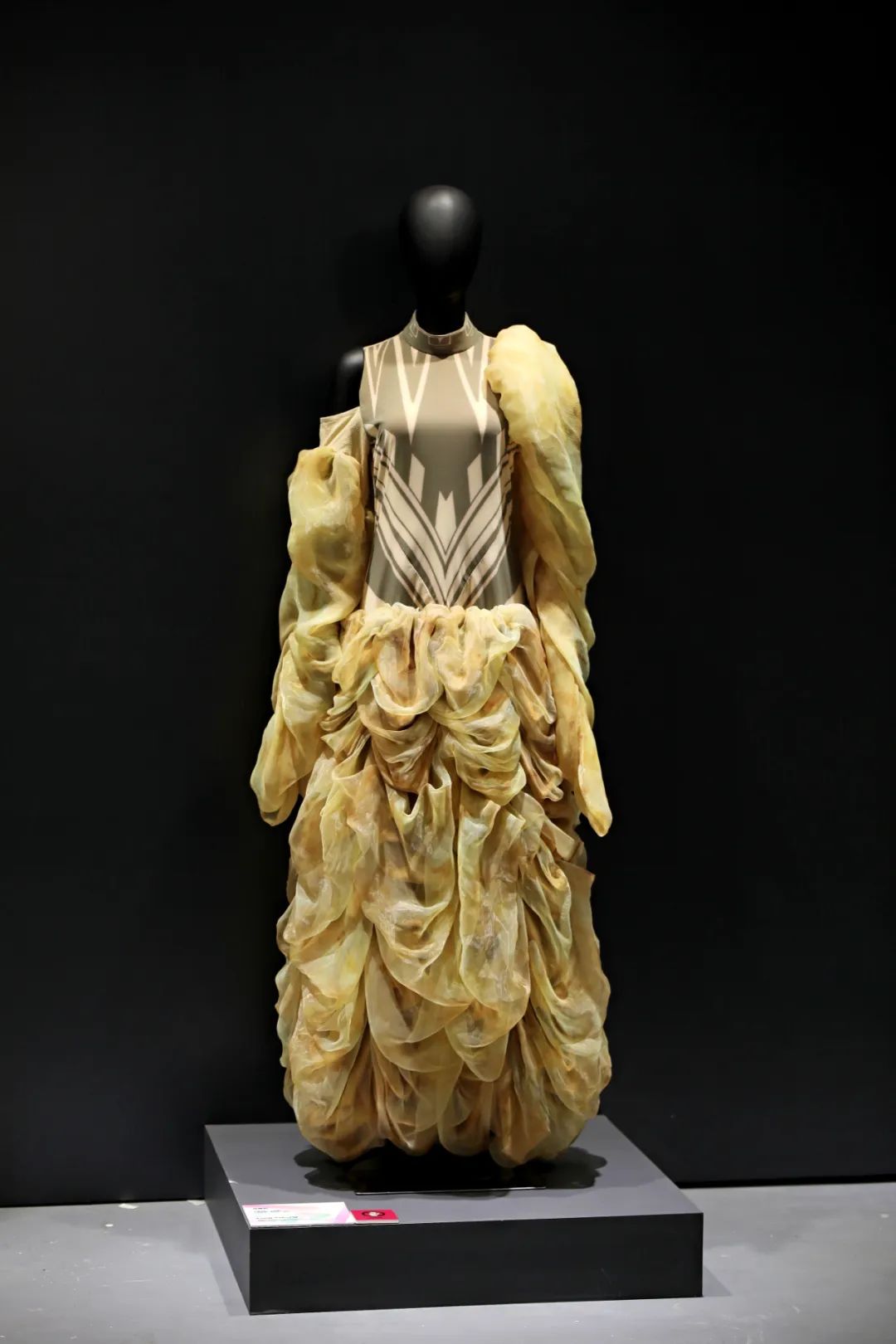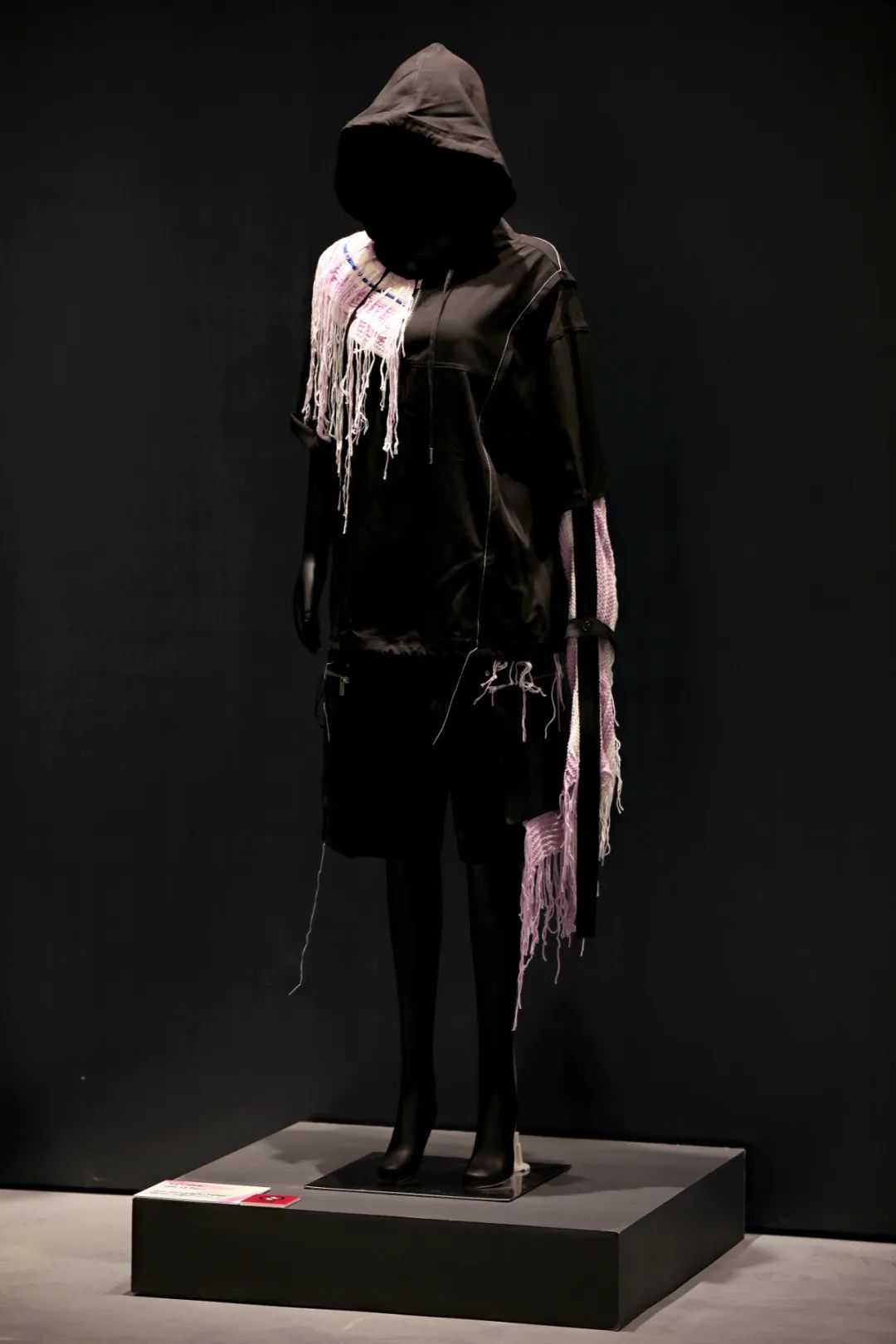
艺术家:黄刚
作品名称:《文脉承续·香云纱·锦·绣·中华》
Title of w
ork: Continuation of Culture, Fragrant Cloud Yarn, Brocade, Embroidery, and China
作品材质:香云纱
Mate
rial(s): Gambiered Guangdong Silk
作品阐释:
设计师以香云纱面料为创作素材,加入“册亨布依族刺绣”元素进行点缀,将两种“中国非物质文化遗产”运用“非遗+科技+时尚”的设计理念赋予古老的手工技艺在未来世界新的生命力。
The designer uses fragrant cloud gauze fabric as the creative material, adding elements of "CehengBuyi embroidery" for embellishment, and applying the design concept of "intangible cultural heritage+technology+fashion" to two "Chinese intangible cultural heritage" to endow ancient handicraft skills with new vitality in the future world.
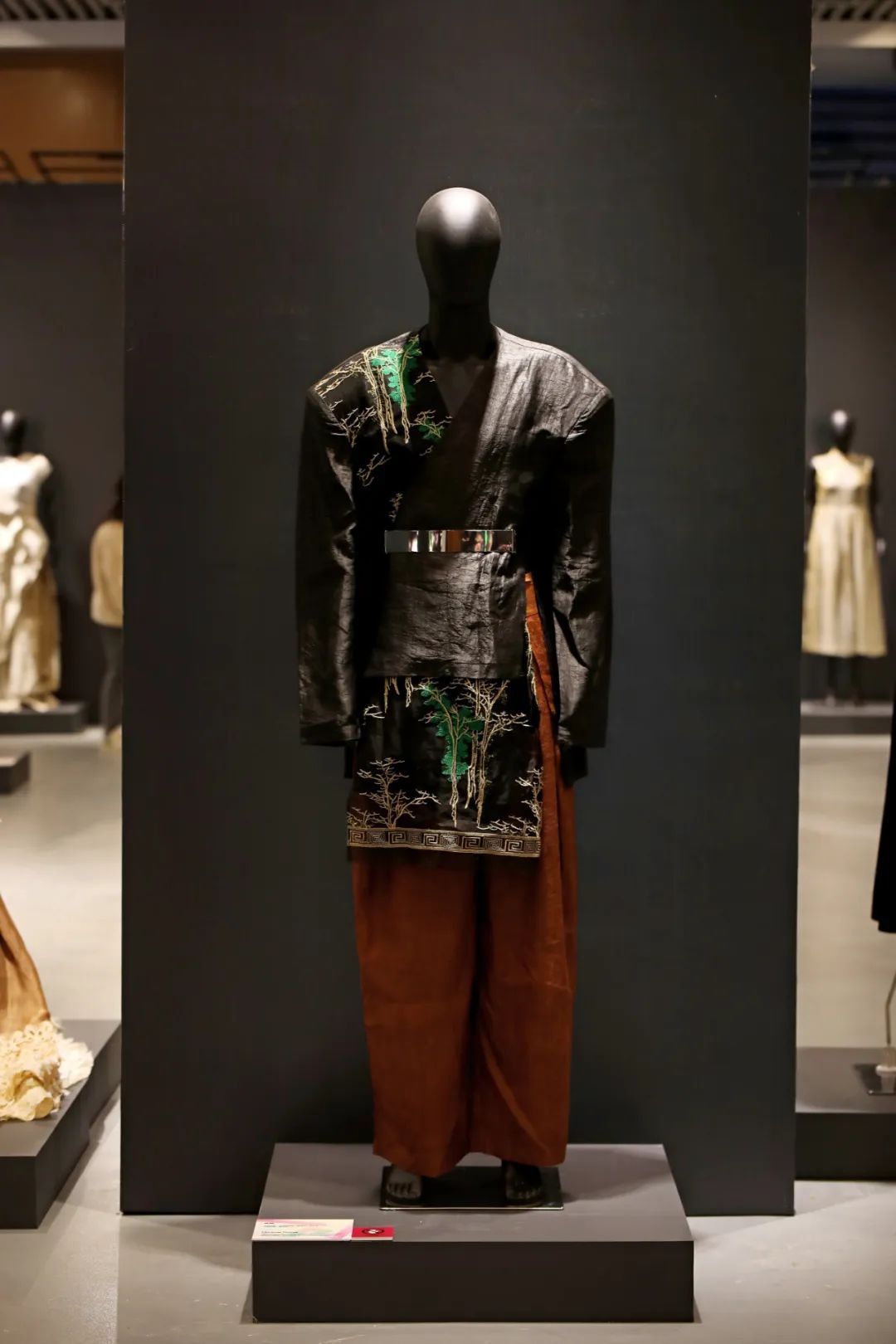
艺术家:王志惠
作品名称:《共生系列- 1》
Title of
work: Symbiosis Series-1
作品材质:牛仔
作品阐释:
“节物致用”是生态美学、造物价值观的综合体现,其追求的是在“和谐”的基础上造物艺术中投入和产出之间的最优比率,体现的是一种可持续发展的生活方式和行为方式。此系列设计作品主要着重于废旧面料的再设计,试图从废弃材料、衣物的回收来进行二次创作,以此诠释持续发展理念,并为作品赋予个人的情感与生命力。
“Saving things for use” is a comprehensive embodiment of ecological aesthetics and creation values, which pursues the optimal ratio between inputs and outputs in the art of creation on the basis of “harmony”and represents a sustainable way of life. This series of works mainly focuses on the redesign of waste fabrics and tries to make secondary creations from the recycling of waste materials and clothes. It interprets the concept of sustainable development and gives the works personal emotions and vitality.
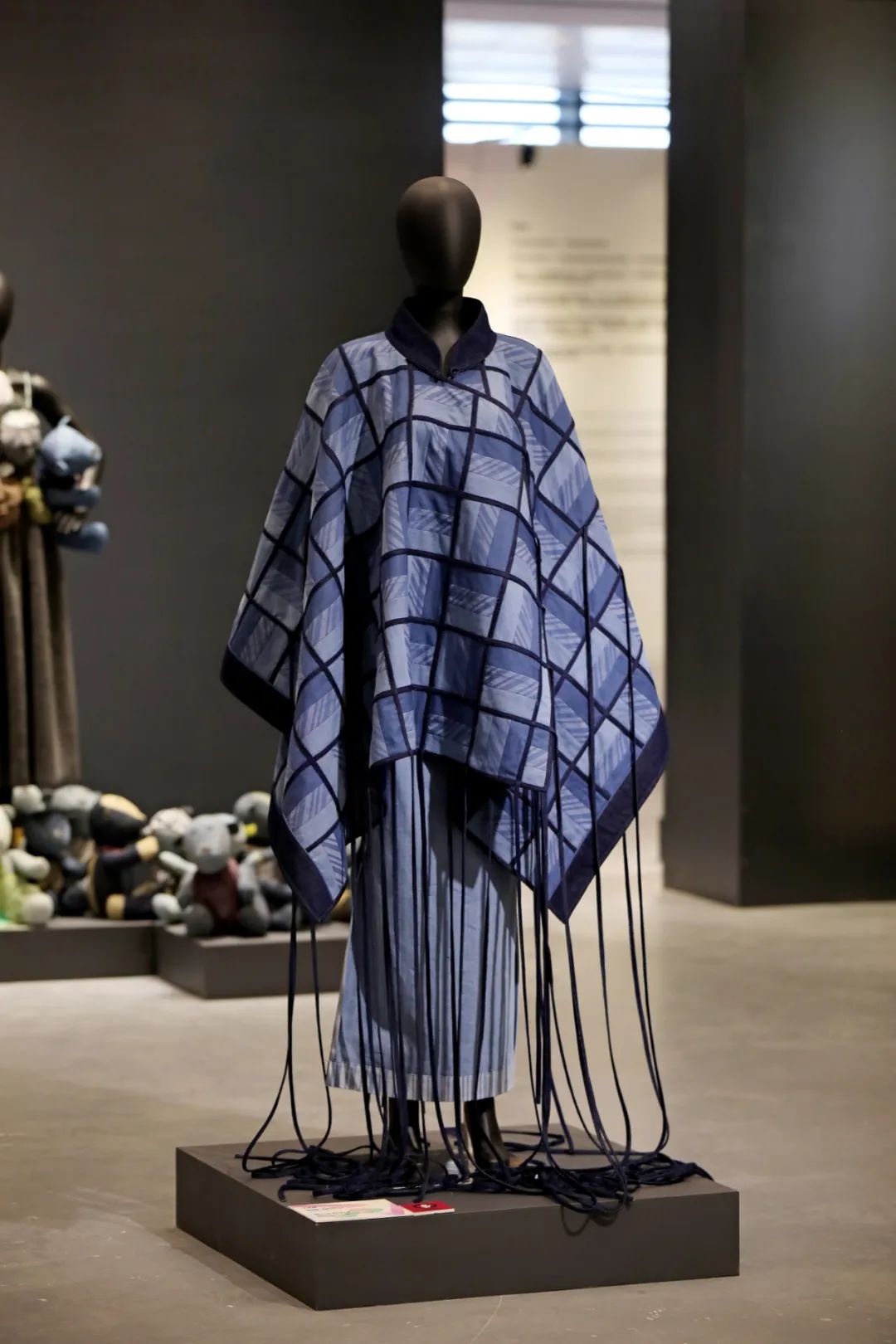
艺术家:马唯
作品名称:《与墨有染—虚实之间》
Title of
work: Staining with Ink – Between the Virtual and the real
作品材质:真丝大缎、真丝素绉缎、真丝绡
Materia
l(s): Pure silk satin, Pure silk crepe satin, Silk gauze
作品阐释:
作品以满族剪纸中的蝴蝶形象为灵感来源,将晚礼服结构与具有长白山地域文化特征的满族剪纸元素相结合,在设计过程中融入水墨构成语言,在设计构思过程中,解构满族剪纸中蝴蝶元素的形式语言,经过多次实验,将其与现代时装设计中的解构形式语言相结合,遵循可持续的服装设计理念,采用真丝素绉缎、大缎、真丝绡等材质结合手工吊染、激光雕刻、复合等工艺探索中国传统水墨形式语言在现代时装中的设计实践方法论,意在将具有长白山地域风情的满族剪纸元素元素通过现代服装设计的方法论重新演绎。
Inspired by the butterfly image in Manchu paper-cutting, this work combines the evening dress structure with the Manchu paper-cutting elements with the regional cultural characteristics of Changbai Mountain, and integrates ink to form the language in the design process. In the process of design conception, it deconstructs the formal language of the butterfly elements in Manchu paper-cutting. After many experiments, it is combined with the deconstructed formal language in modern fashion design, following the concept of sustainable fashion design. Pure silk satin, pure silk crepe satin, silk gauze and other materials are used to explore the design practice methodology of China traditional language in modern fashion, in order to reinterpret Manchu paper-cut elements with Changbai Mountain regional flavor through the methodology of modern fashion design.
艺术家:鲍殊易
作品名称:《世界两侧》
Title
of work: On Both Sides Of The World
作品材质:醋酸缎、欧根纱、纺织染料
Mate
rial(s): Acetate satin, organza, textile dyes
作品阐释:
《世界两侧》水墨在我国传统文化意义上可谓是中国绘画之魂,图形在当代视觉传达方式上也是最重要的设计语汇。该设计基于墨点丰富的偶发形式,以平面和立体的视角,结合人体的曲线变化,通过不同的“形”,去表达传统服饰之美的“意”。以传统旗袍的廓形作为基本框架,采取发散性的思维去理解传统工艺的表达形式,使用了水墨手绘、刺绣、镂空等工艺手段去探索现代视角下的传统服饰美学模式。
Ink painting《 On Both Sides Of The World》 is the soul of Chinese painting in traditional Chinese culture, and graphics are also the most important design vocabulary in contemporary visual communication. This design is based on the occasional form of rich ink dots, using a flat and three-dimensional perspective, combined with the changes in the curves of the human body, to express the beauty of traditional clothing through different "shapes". Using the silhouette of traditional cheongsam as the basic framework, divergent thinking is adopted to understand the expression forms of traditional craftsmanship, and techniques such as ink painting, embroidery, and hollowing out are used to explore the aesthetic mode of traditional clothing from a modern perspective.
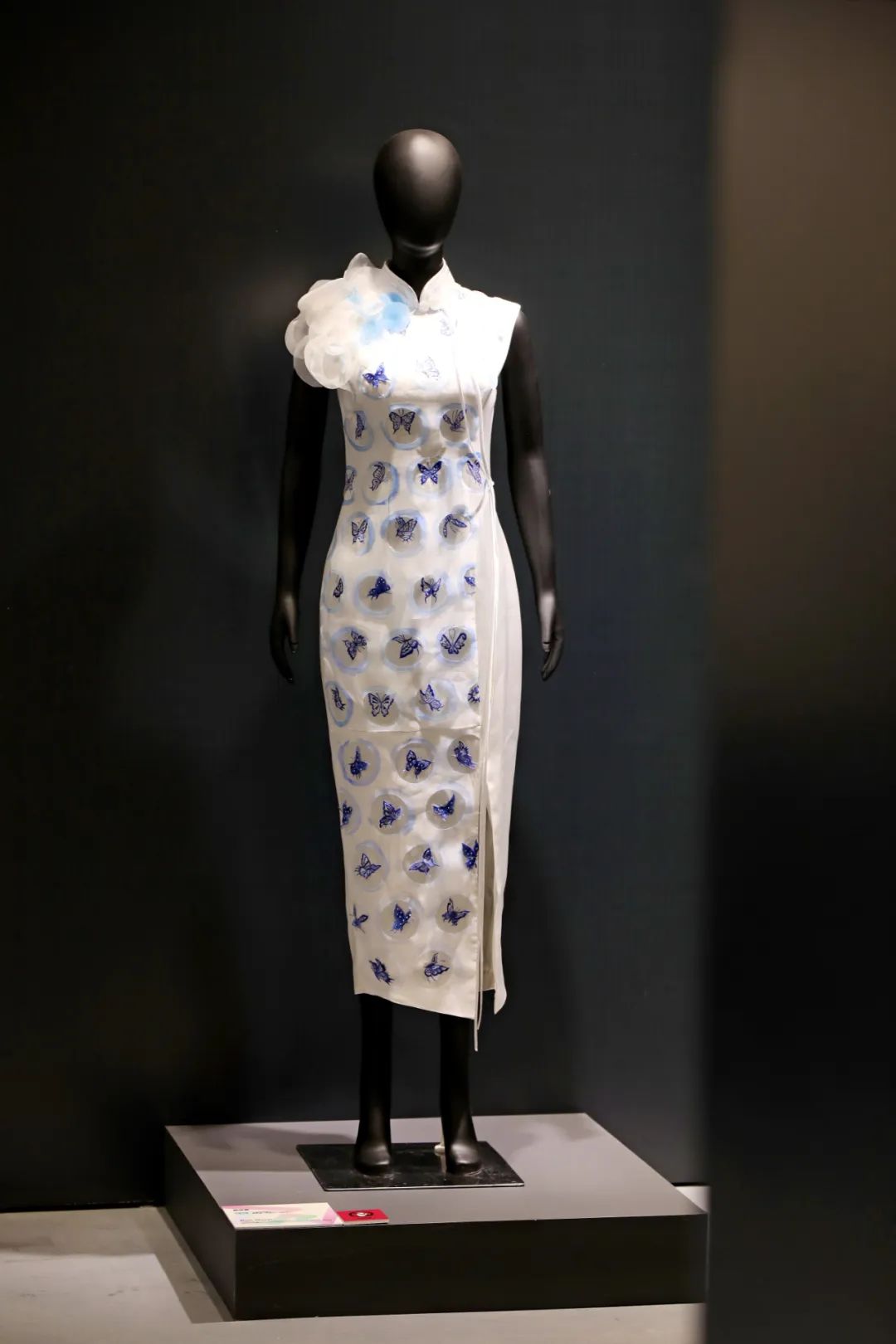
艺术家:赵佳蓉
作品名称:《相生陆离》
Title of w
ork: Xiāng Shēng Lù Lí
作品材质:毛呢、莱赛尔纤维
Materi
al(s): Wool, lessel fibers
作品阐释:
《老子.第二章》:「故有无相生、难易相成、长短相较、高下相倾。」
《淮南子·本经训》:“五采争胜,流漫陆离。”
情绪、生长、痕迹和空间的表达是这个系列所关注的部分。通过印花、绣花、针织等综合工艺做了情绪性色彩的表达,运用几何感的服装去视觉化人意识的空间感。人们常聊外界环境与自我价值的关系,实现自我价值的驱动力是由内自外的,所以佳蓉从花的生长状态中提取图形与逻辑关系运用到服装版型的创新中,含苞到盛放、由点及面的中心散射能量,内驱动的来源则是一直滋养你的精神力量。立体结构分布在人的肩膀、膝盖、手肘等等部位,实现一种雕塑感的时装效果,运动时会与服装产生交互变化。也取了「相生」这个词,传达的是一个积极的生长状态;随即选取了「陆离」这个词,它是期许的一种结果,希望通过这个系列表达这个世界是多彩的、绮丽繁杂的。色彩是多元的、渐变的、相融的,仿佛人类的情绪和情感也是流动着的。
In this project,focusing on the emotions、growth、traces and space. Throughing printing、embroidery、knitting and other comprehensive processes,for the expression of emotional colours. Using of geometric garments to visualize the sense pf space of human consciousness. When the people talking about the relationship between the external environment and personal worth,and the driving force for realizing self-worth is from the inside out,so Jiarong extracts the graphic relationship from the growth status of the flower and applies it to the innovation of the garments pattern cutting methodology. The three-dimensional structure is distributed on the shoulders, knees, elbows and other parts of the human body, to achieve a sculptural fashion effect, and will interact with the 3d structure of the garments when the person moving. The word "Xiang Sheng" is also taken to convey a positive state of growing status; The word "Lu Li", which is a result of expectations, hoping to express that the world is colorful and complex through this project. The colors are diverse, gradual, and blended, as if human emotions are also flowing.

艺术家:贺萌萌
作品名称:《桀骜少年》
Title of w
ork: Unruly Youth
作品材质:羊毛、牛仔、纱线、废弃边角料
Material(
s): wool, denim, yarn, scrap
作品阐释:
作品采用纺织废料完成,将纤维材料解构重组,创造出新的形态,诠释了无惧一切、勇于突破和重塑自我的少年精神。
The work is made of textile waste, deconstructs and reorganizes fiber materials to create a new form, and interprets the youth spirit of fearless, brave to break through and reshape themselves.
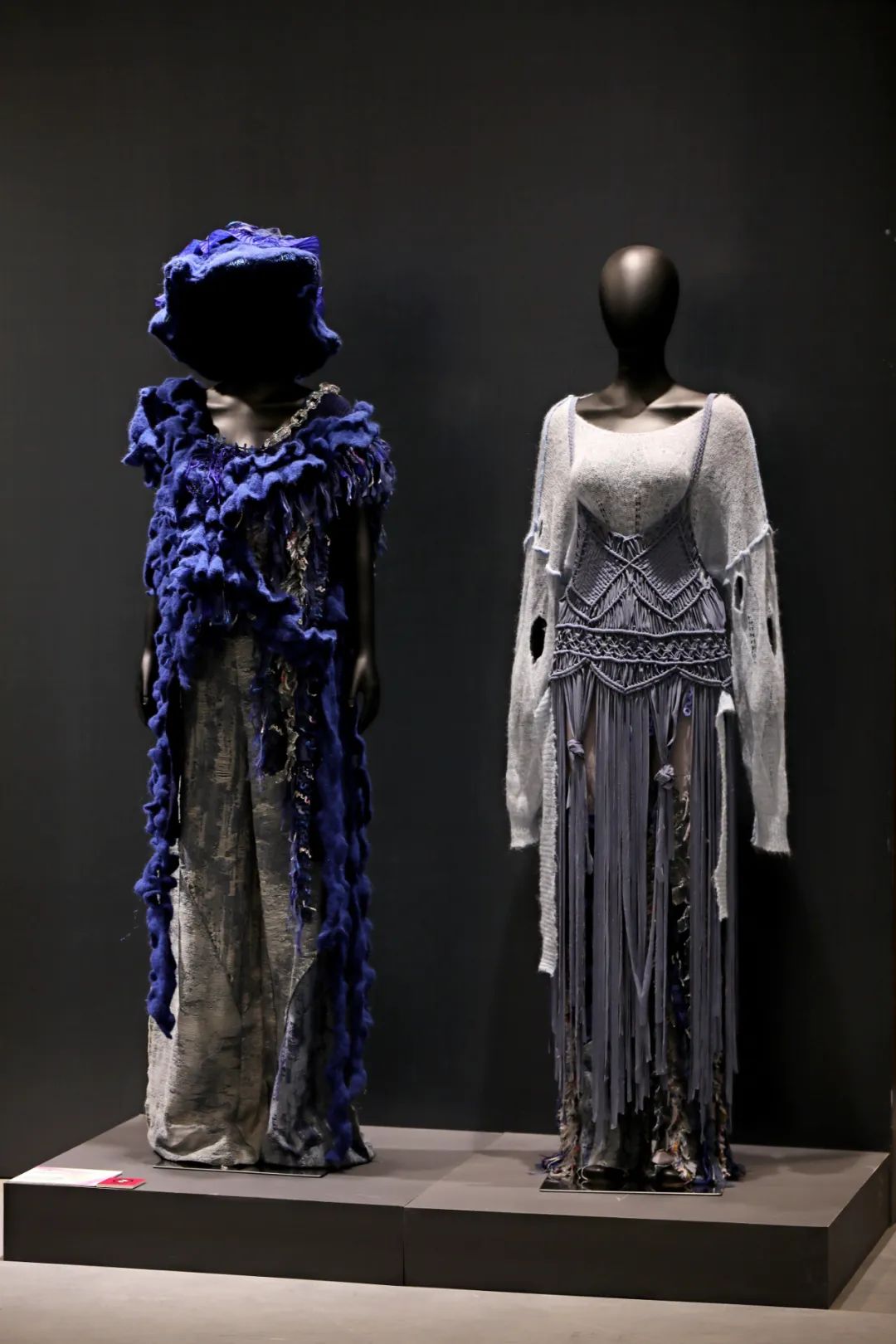
作品名称:《The Walking Rock》
Title of w
ork: The Walking Rock
作品材质:牛仔、胶、蕾丝
Materi
al(s): Denim, Coating Adhesive, Lace
作品阐释:
这一系列服装灵感源于坚韧不拔的石头,以废旧的牛仔裤为素材,巧妙地拼接出裂缝般的分割线,并通过涂层胶、蕾丝与牛仔面料的独特组合,呈现出仿佛是石头自然裂缝的效果。这些服装象征着一群与众不同的人,他们坚强如石,喜欢挑战常规,不断改变游戏规则,重新定义生活方式。在这个转变的过程中,他们释放内在的自然本性,用服装来表达自我。
Inspired by the resilience of the stone, this collection of garments is made from used jeans, skillfully spliced with crack-like dividing lines and presented as if they were natural cracks in the stone through a unique combination of coated adhesive, lace and denim fabrics. These garments symbolize a group of distinctive people who are as strong as stone, who love to challenge the norm and constantly change the rules of the game to redefine their lifestyle. In this process of transformation, they unleash their inner nature and use clothing to express themselves.

艺术家:黄子棉
Artist:Huang Zimian
作品名称:《时间》
作品材质:夏布
Ma
terial(s): Grass cloth
作品阐释:
时间(Time)是物质的永恒运动、变化的持续性、顺序性的表现。将代表时间的东方传统元素和生活哲学,与现代立体裁剪与制作工艺相结合,赋予传统文化传统材质、工艺新的生命。作品把东方印象以独特混搭的表达方式带进人们的视野,以服装中最常见的领子为切入点,通过领子基本型不停变化发挥创意,以一件代表了现代穿着方式的西装与衬衫延展开,中间穿插了各种不同的领形以此打造不规则造型的外套以及裙摆;颜色方面直接沿用了夏布的原始色彩;面料则采用了重庆非物质文化遗产——“荣昌夏布”,笔者特意去民间搜集了年代久远的手作夏布,带有古朴质感、颇具时间感、年代感的夏布集中体现了中国劳动人民的工艺智慧,富有中式韵味,用拼接或镂空或磨毛边的方式打造服装的细节;近未来式科技感的东方流线造型与西方的立体镂空工艺渗透到设计当中,融汇中西。
Time is the manifestation of the eternal movement, continuity, and sequence of changes in matter. Combining traditional Eastern elements and life philosophy representing time with modern three-dimensional cutting and production techniques, giving new life to traditional materials and craftsmanship in traditional culture. The work brings the Eastern Impression into people's vision through a unique mix and match expression, using the most common collar in clothing as a starting point. Through the constant changes in the basic shape of the collar, creativity is unleashed, with a suit and shirt representing modern fashion extending, interspersed with various collar shapes to create an irregular shaped jacket and skirt; In terms of color, it directly follows the original color of summer cloth; The fabric adopts the intangible cultural heritage of Chongqing - "RongchangSummer Cloth". The author specifically went to the folk to collect handmade summer cloth from ancient times. The summer cloth with a simple texture, a sense of time, and a sense of era reflects the technological wisdom of the Chinese working people, rich in Chinese charm, and uses splicing, hollowing out, or grinding edges to create clothing details; The modern and futuristic style of Eastern streamline design and Western three-dimensional hollowing out techniques permeate the design, blending Chinese and Western elements.
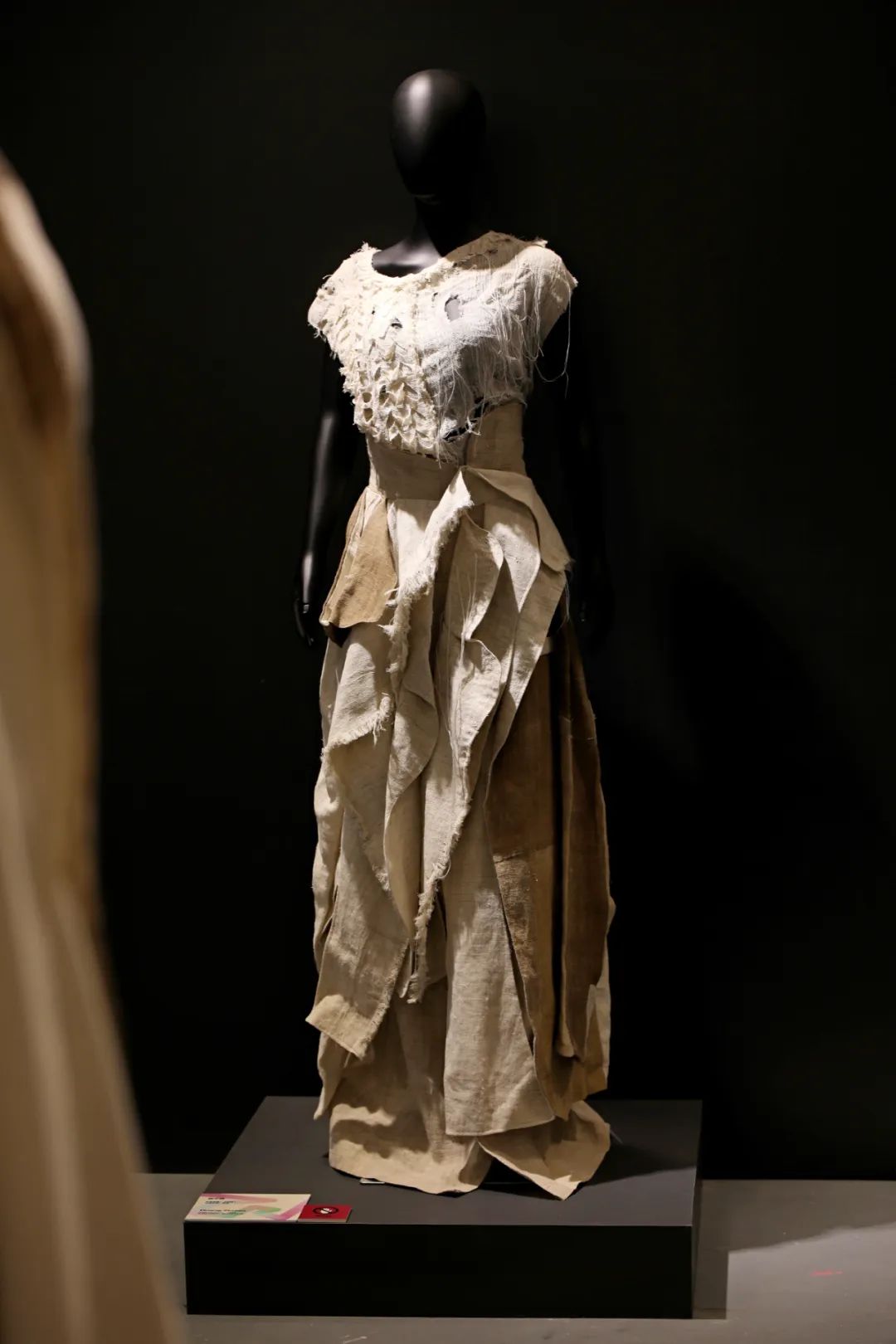
艺术家:文华祥
作品名称:《你看,天亮了》
Title of w
ork: You see, the night passed
作品材质:棉布、珠子
Mat
erial(s): Cotton, beads
作品阐释:
织物经吊染后呈现出渐变色彩似黎明来临前的夜晚,未经浸染的织物表面有些许白色,似黎明前的星星若隐若现。不同颜色的水拓染料交错纵横,在织物表面呈现丰富的色彩,表现出太阳缓缓升起时天空中的颜色更替变化。织物表面有许多不同的珠子串连在一起,就像生活中的每一个人紧密相连,在阳光的照耀下熠熠生辉。
After the fabric is hung and dyed, it shows a gradient color, like the night before dawn, and the surface of the undyed fabric is slightly white, like the stars looming before dawn. The different colors of the water dye are crisscrossed and crisscrossed, showing a rich color on the surface of the fabric, showing the color change in the sky as the sun slowly rises. There are many different beads strung together on the surface of the fabric, just like everyone in life is closely connected, shining in the sun.
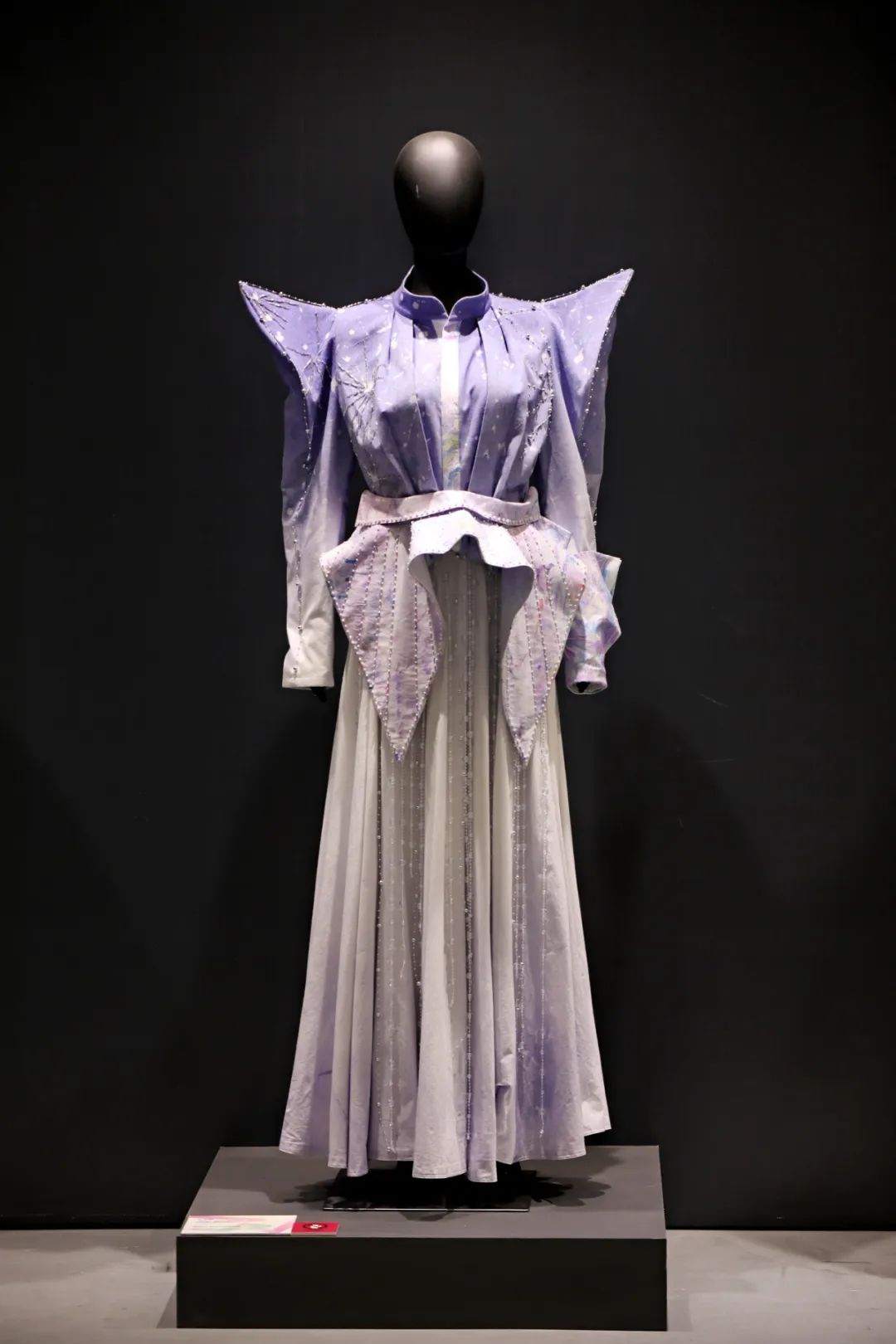
艺术家:林岚
作品名称:《视窗》
作品材质:纯羊毛西服面料、植绒丝网印、欧根纱、醋酸缎
M
aterial(s): Pure wool suit fabric, flocked silkscreen, organza yarn, acetate satin
作品阐释:
作品以概念化的“视窗”具像延伸至“石生花”作为设计核心内容,并以其生命理念融入到图案设计中,阐述当代女性的智慧、自信与表达独立自我的多变风格。服装整体以黑色作为主色,视觉感舒适的同时又富有灵动和张力。
The work extends the conceptual concept of "window of sight" to "stone flowers" as the core design content, and integrates its life concept into the pattern design, elaborating on the wisdom, confidence, and diverse style of expressing independent self of contemporary women. The overall color of the clothing is black, which is visually comfortable while also full of flexibility and tension.
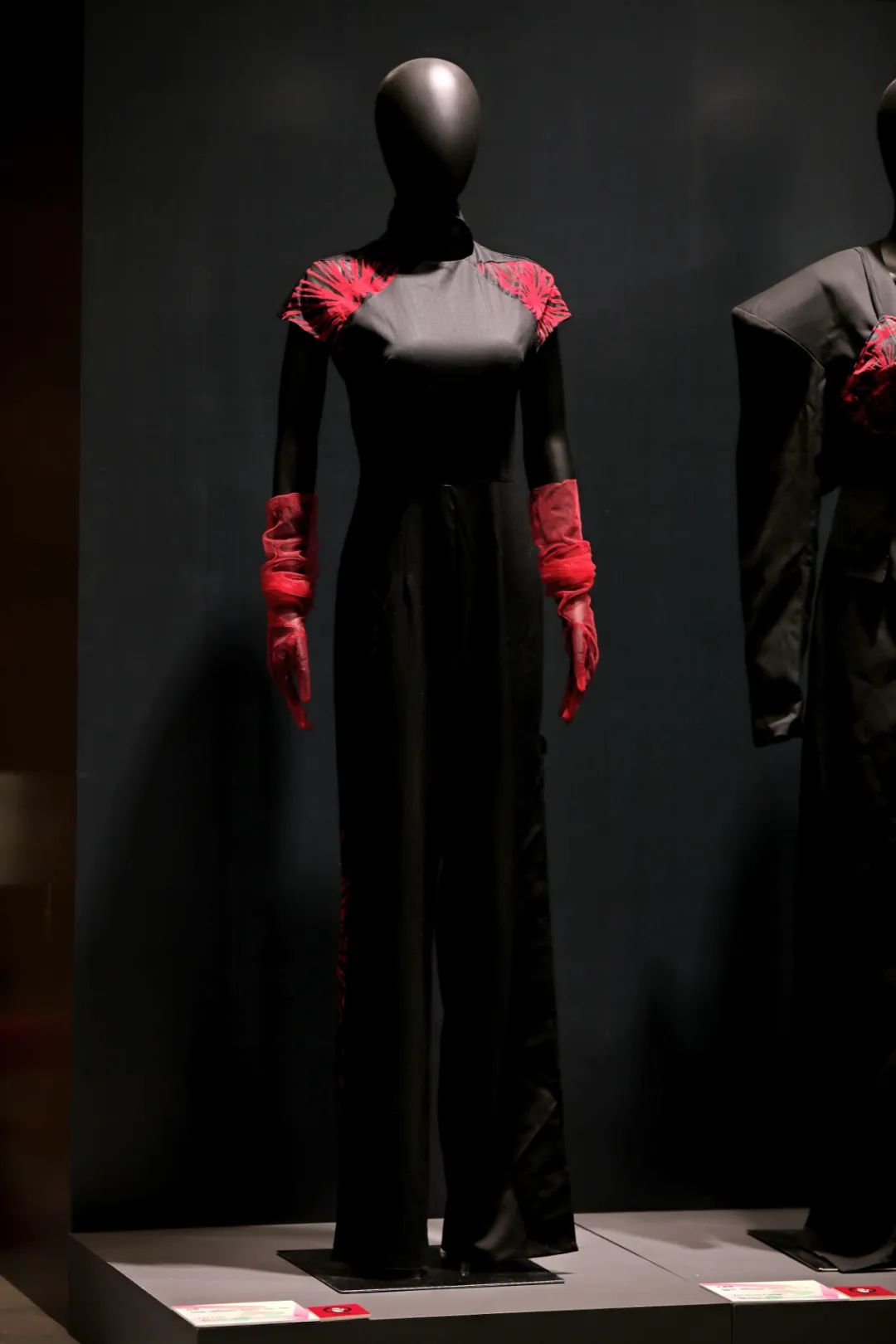
艺术家:尹雪程
作品名称:《视窗》
作品材质:纯羊毛西服面料、植绒丝网印、欧根纱、醋酸缎
Material(s): Pure wool suit fabric, flocked silkscreen, organza yarn, acetate satin
作品阐释:
该作品以概念化的“视窗”到具像化延伸物“石生花”作为设计的核心内容,以石生花的生命理念融入到图案设计中,阐述了当代女性的智慧、自信与表达独立自我的多变风格。服装整体以黑色作为主色,视觉感舒适的同时又富有灵动和张力,给人刚柔并济的美感。
The work takes the conceptual "window" to the figurative extension "Shi Sheng Hua" as the core content of the design, and integrates the life concept of ShiSheng Hua into the pattern design, expounding thewisdom, confidence and changeable style ofcontemporary women's wisdom, confidence andexpression of independent self. The overall clothinguses black as the main color, which is visuallycomfortable and full of flexibility and tension, givingpeople a sense of beauty that is both rigid and soft.
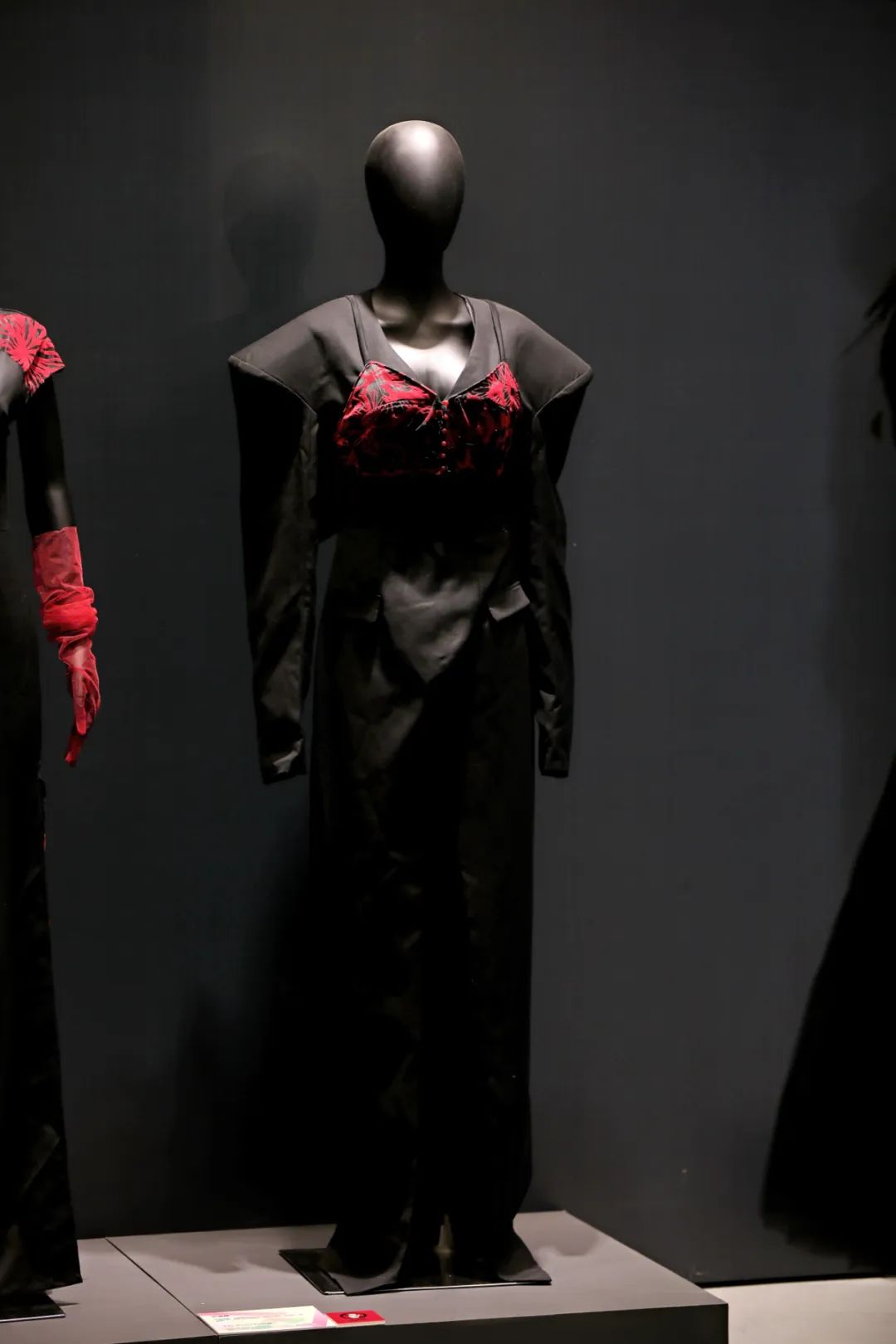
艺术家:张秋实
作品名称:《天衣有缝》
Title of wo
rk: Sewn clothes
作品材质:宣纸
作品阐释:
《天衣有缝》灵感来自成语“天衣无缝”,“天衣无缝”意为“无人为造作”的痕迹,引申为做事没有一点儿破绽、完美无缺。然而,完美主义会陷入一种焦虑甚至恐惧的心理状态,一帆风水是我们的生命期待,但非生活常态。生活在内卷时代的我们,符合自身逻辑的自洽状态或许是关系相处的一条路径。作品《天衣有缝》系列用宣纸层层粘贴做成一件件衣服,衣服的缝隙处嵌有用宣纸撕、捻、卷、贴而成一幅文人雅士的微观山水画。当灯光亮起,山水画在衣服缝隙处显现。作者认为,衣服是人的第二层皮肤,山水是心灵外化于自然界的灵魂承载,这二者互为表里,也构建了现代人精神追求的一种新的延续性、可读性和可视性。
The inspiration for "Sewn clothes" comes from the idiom "Heavenly Clothes with Seams", which means the trace of "no one's work is artificial " and extends to "doing things without any flaws, perfect and flawless". However, perfectionism can fall into a state of anxiety or even fear, where a sail of feng shui is our life expectation, but not the norm. Living in the era of involution, a self consistent state that aligns with our own logic may be a path for relationships to get along. The work "Sewn clothes" series uses layers of rice paper to paste clothes, and the gaps in the clothes are embedded with rice paper to tear, twist, roll, and paste, creating a microscopic landscape painting of literati and refined scholars. When the light shines, the landscape painting appears in the gaps of the clothes. The author believes that clothing is the second layer of human skin, and mountains and rivers are the soul carriers that externalize the soul in nature. These two are mutually exclusive and construct a new continuity, readability, and visibility that modern people pursue in their spiritual pursuits.
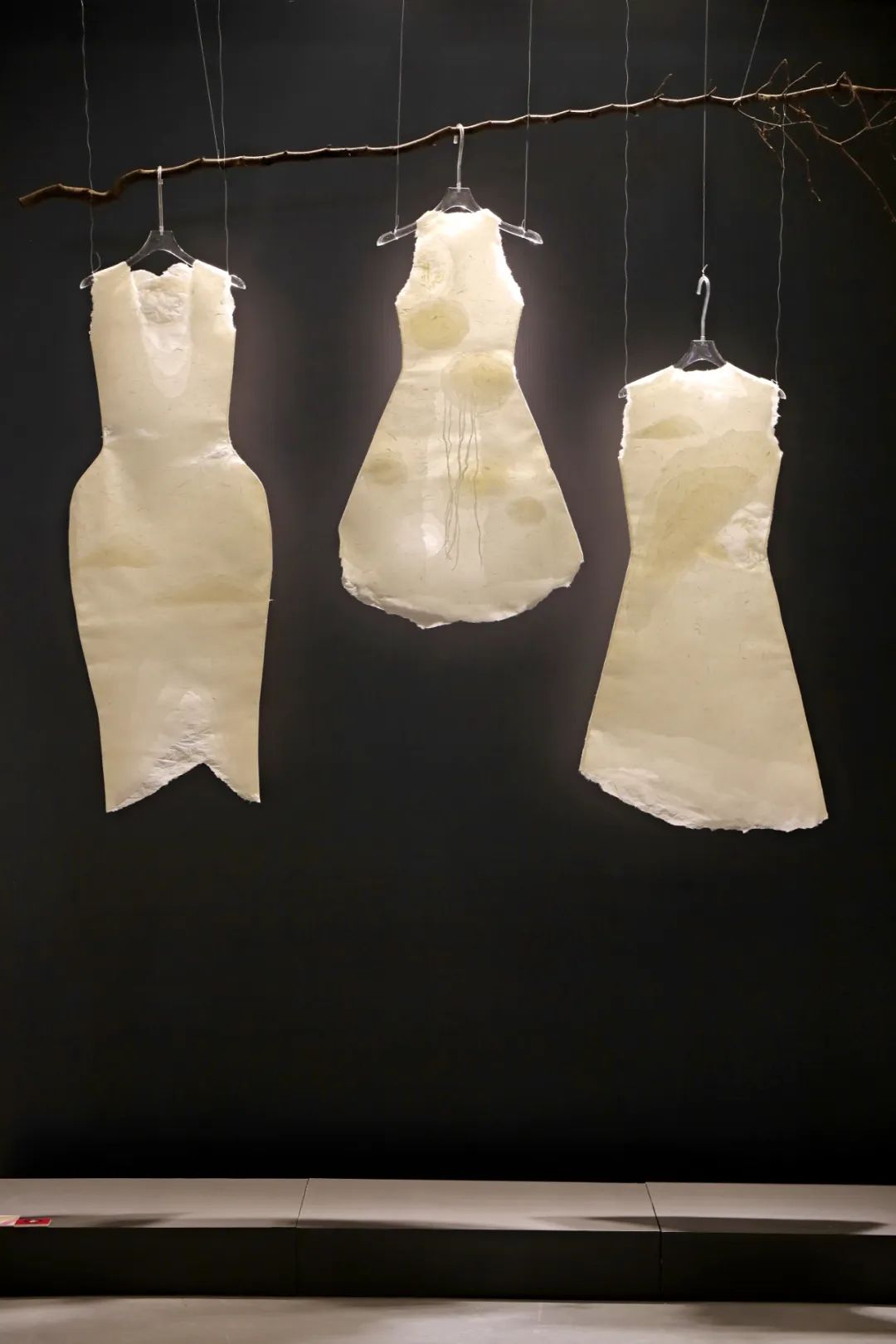
艺术家:许少玲
作品名称:《百衲·福》
Title of wo
rk: Patchwork · Fortune
作品材质:棉、麻
Materia
l(s): Cotton, Linen
作品阐释:
“至于大背情理,可为人心世道之忧者,则零拼碎补之服,俗名呼为‘水田衣’者是已”。(李渔《闲情偶寄》)——拾取零碎布料重新拼接缝补成一件新的衣服,在明代妇女中尤为流行,其造物意识中不仅蕴含了朴素的“惜物”、“惜福”、"低碳"的可持续观念,不厌其烦反复的手工拼接更是用心与手中织物在轻言细语交流。
Patchwork is also called "water-field clothing”. Picking up pieces of fabric and stitching them together into a new cloth, was very popular among women in the Ming Dynasty. Its creative consciousness not only contains the simple "treasure", "happiness" and "low-carbon" sustainable concept, but also the tireless and repetitive manual stitching, which represented a heartfelt communication between the hands and the woven fabric, conveyed through delicate and gentle words.

艺术家:赵丹彤
作品名称:《重塑记忆》
Title of wo
rk: Reshaping memory
作品材质:纱、丝线、有机玻璃
Mater
ial(s): Yarn, Silk thread, Perspex
作品阐释:
作品以江南文化为设计背景,意图将其中的美性、文性、诗性、知性等文化特质展现出来,整体意境虚实结合,将江南传统审美意象进行重新诠释,富有当代服饰设计美学思想意蕴。作品造型以江南古建筑为设计灵感,采用层叠、交叉等立体设计手法,色彩选用中国传统色彩五间色中宛如 “映日荷花别样红”的红色,并提取中国清代传统“喜相逢”纹样中的构图形式,将鸟纹样进行抽象化创新设计,作品整体大气写意中不乏灵动细腻,独具烟雨江南的气韵,充分展现东方美意。
The work takes Jiangnan culture as the design background, intending to show the beauty, literary, poetic, intellectual and other cultural characteristics,the overall artistic conception, the combination of virtual and real, the reinterpretation of the traditional aesthetic image of Jiangnan, rich in the aesthetic implication of contemporary costume design. The shape of the work is based on the design inspiration of Jiangnan ancient buildings, it adopts three-dimensional design techniques such as cascading and crossing. The colors are selected from traditional Chinese colors, the color is like a different red lotus, and the composition form of the “Xi Xiang Feng” pattern of the Qing Dynasty is extracted, and the bird patterns are abstracted and innovated. The overall atmosphere of the work is full of agility and delicacy, unique charm of the misty rain in the south of the Yangtze River, fully demonstrating the beauty of the East.
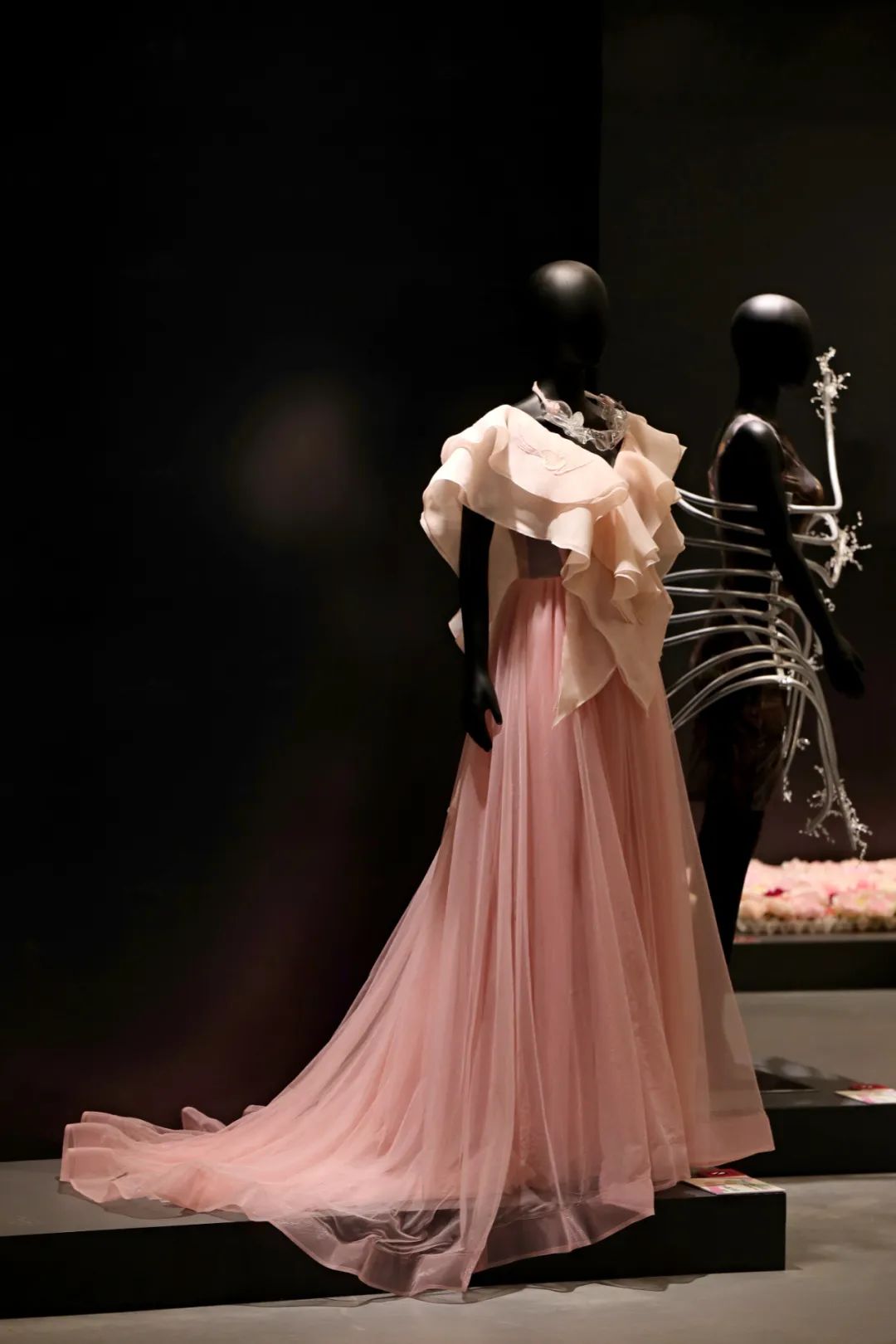
艺术家:张焕霞
作品名称:《迁徙》
Title of w
ork: MIGRATION
作品材质:斜纹仿毛面料、柞蚕丝棉、棉、麻
Materia
l(s): Twill wool-like fabric, tussah silk cotton, cotton, linen
作品阐释:
作品名称为《迁徙》,借鉴岭南地区的盘瑶传统服饰的八角花图案和人形纹图案,利用手工刺绣工艺在袖口和腰封处绣制。八角花纹在盘瑶民族观念里具有吉祥寓意,穿着绣有八角花纹样的服饰就能不受鬼怪伤害,逢凶化吉,身体健康。盘瑶服饰的人形纹都是连着一排绣制,没有单个出现的人形纹,说明盘瑶人民在民族迁徙过程中,不管是对抗自然灾害、猛兽攻击还是外族侵略,都是团结一致的状态,表达盘瑶人民积极向上的民族性格和坚韧不拔的民族精神。
The name of the work is Migration, which draws lessons from the octagonal flower pattern and humanoid pattern of Panyao traditional costume in Lingnan area, and is embroidered at cuffs and waist seals by hand embroidery technology. The octagonal pattern has auspicious meaning in Panyao's national concept. Wearing clothes embroidered with octagonal pattern can protect you from ghosts, and you will be healthy. The human figure patterns of Panyao costumes are all embroidered in a row, and there is no single human figure pattern, which shows that Panyao people are in a state of unity in the process of national migration, whether against natural disasters, beast attacks or foreign aggression, expressing Panyao people's positive national character and indomitable national spirit.
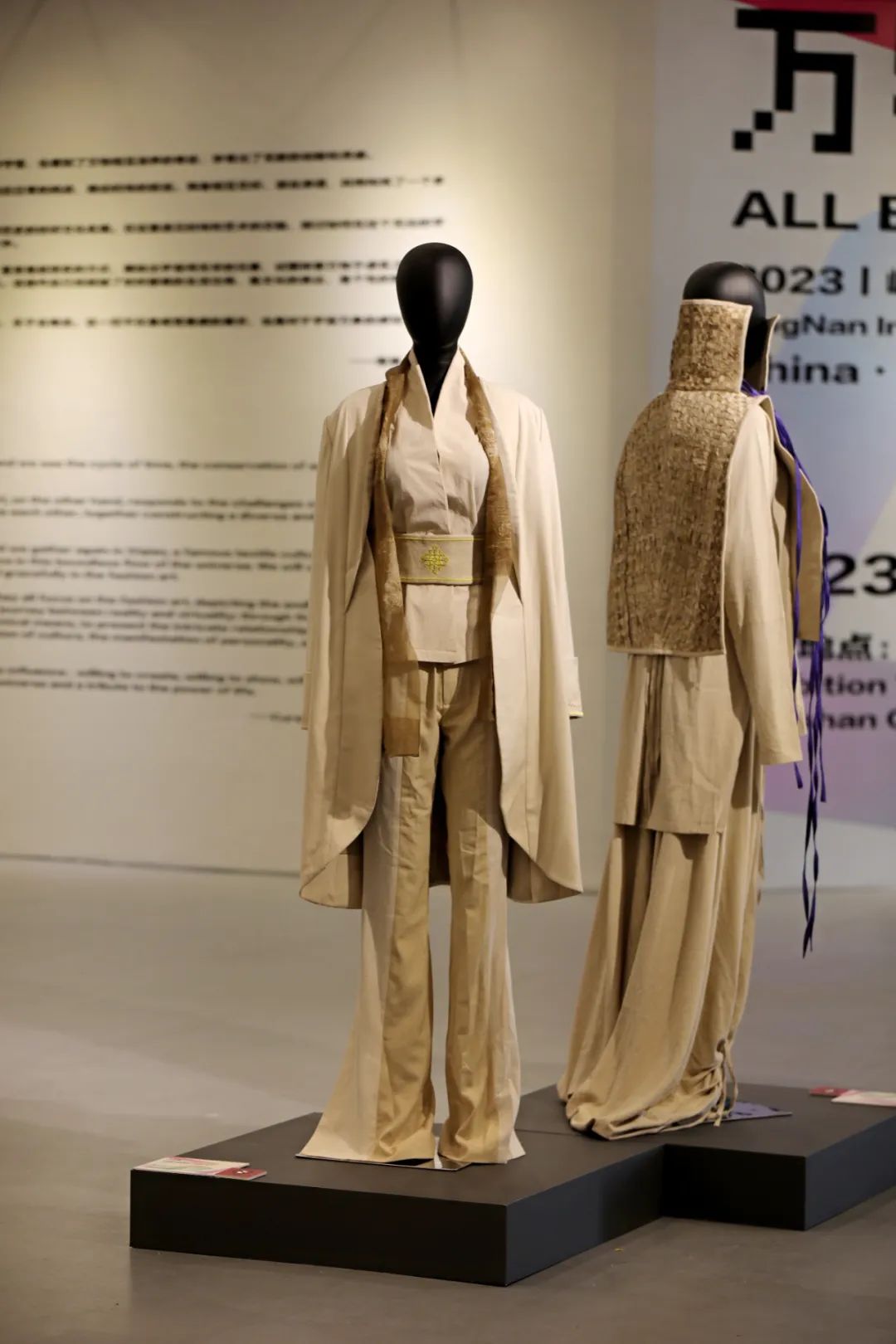
艺术家:熊艺
作品名称:《织植纸制系列之三》
Title of w
ork: Weaving and Planting Paper
作品材质:构皮、棉、麻、丝
Materi
al(s): Suede, Cotton, Linen
作品阐释:
《织植纸制》系列作品,作者分别丛“织”、“植”、“纸”、“制”四个象形文字的形态与寓意中提取创作灵感。在工艺方面,融入了“织”传统织布工艺,“纸”古法造纸
技术。
在材料与制作方面
,融入了
“
植
”
植物纤维,
“
制
”
新材料的
研
制以及
设计裁剪与制作。
“
织植纸制
”
系列作品的材料
“
是布非布,是纸非纸
”
。
用新的材料述说两个时间阶段,两个技术文化的跨界交融。
The series of works "Weaving and Planting Paper Making" extract creative inspiration from the forms and meanings of the four hieroglyphs "weaving", "planting", "paper", and "making". In terms of craftsmanship, it incorporates the traditional weaving process of "weaving" and the ancient papermaking technology of "paper". In terms of materials and production, it integrates the development of "planting" plant fibers, "making" new materials, as well as design, cutting, and production. The material used in the "Weaving and Planting Paper" series of works is "cloth not cloth, paper not paper". Use new materials to describe the cross-border integration of two time periods and two technological cultures.

艺术家:俞红霞
作品名称:《穿过自己》
Title of
work: BE PERMEATED
作品材质:欧根纱茶染、柿染、手织
Material(s
): Tea-dyedogen yarn, persimmon-dyed, hand-woven fabric
作品阐释:
人生最难的就是“我执”,允许万物穿过自己,如服装一般,允许风儿穿过,允许阳光透过,让自己去丰盈中生长。
The toughest in life is "perseverance". We hold on, allowing everything to go through us, like clothing. We hold on, allowing wind to touch hearts and sunshine to bathe minds.We hold on, allowing ourselves to be growing in abundance.

艺术家:张爱莉
作品名称:《衣上风景》
Title of
work: Scenery on Clothes
作品材质:女裙、树枝、树根、棉线等
Material
(s): Dress, Branches, Tree Roots, Cotton Threads
作品阐释:
这件作品是作者的树枝山水系列装置从墙面到服装上的尝试。服装是穿在身上的风景,作者将树枝与根须之间灵动的线条感和虚实关系进行具有独特秩序感的布局,营造充满层次感的空间,构建衣上的抽象水墨意境,赋予一条温和女裙以力量及神秘幽静的禅意。
This work is the artist‘s attempt to move from the wall to the clothing of her Tree Branch Landscape series of installations. Clothing is the Scenery worn on the body, the author arranged the dynamic sense of lines between branches and roots and the relationship between reality and virtual layout with a unique sense of order, to create a sense of layered space, to build the abstract imagery of ink on the clothing. This work is endowed a gentle women's dress with the power and mysterious Zen meaning.
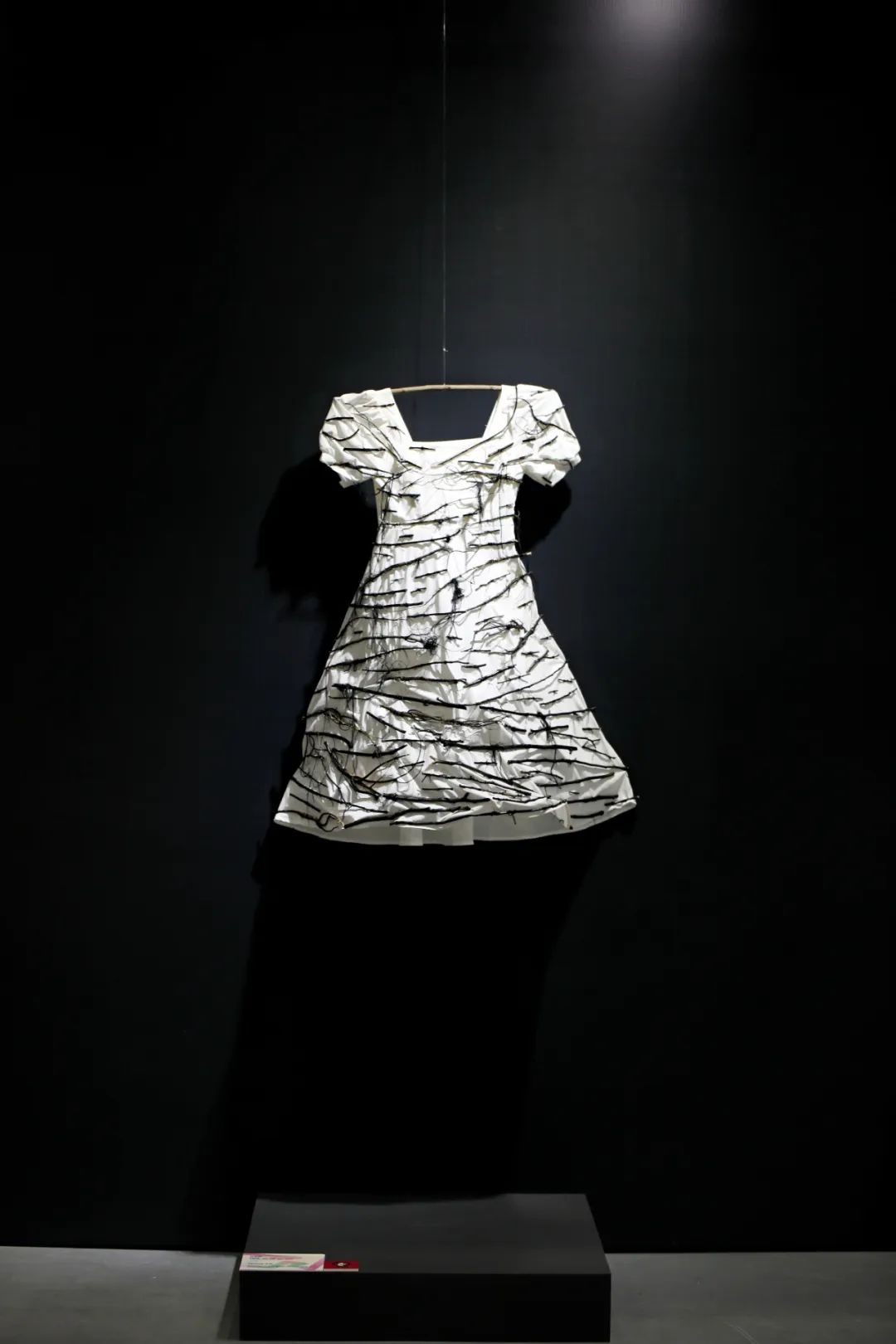
艺术家:邹莹、周强
Artists:Zou Ying, Zhou Qiang
作品名称:《织韵》
Title of w
ork: Weaving Rhyme
作品材质:棉
作品阐释:
《织韵》系列由三套服装组成,主要表现:1、手工和时尚。本系列服装全部采用手工编结工艺完成;2、历史和时装。光怪陆离的现代时装追溯起来,其源头是骨针纺轮,搓绳捻线,该系列造型既有机甲朋克的元素,亦有手编流苏的飘逸,致敬深厚的人文历史。3、作者团队来自甘肃,故选取敦煌壁画中的宝相花为主要装饰元素,西北与岭南遥相呼应,颇有意趣。综上,编结为工艺,宝相为表现,服装为载体,作品《织韵》致敬“万物流向——2023岭南国际时装艺术(邀请)双年展”。
The "Weaving Rhyme" series consists of three sets of clothing, mainly manifested as: 1. Handmade and fashion. All clothing in this series is completed using manual weaving techniques; 2. History and fashion. The dazzling modern fashion can be traced back to its roots in bone needle、 spinning wheel、 twisting ropes and threads. The design of this series combines the elements of mech punk and the elegance of hand woven tassels, paying tribute to profound cultural history. 3. The author's team comes from Gansu, so the dignified and graceful composite flowers in Dunhuang murals are selected as the main decorative elements, echoing the northwest and Lingnan in a distance, which is quite interesting. In summary, weaving is the craft, Baoxiang flower is the expression, and clothing is the carrier. The work "Weaving Rhyme" pays tribute to "The Flow of Everything -2023 Lingnan International Fashion Art (Invitation) Biennale".
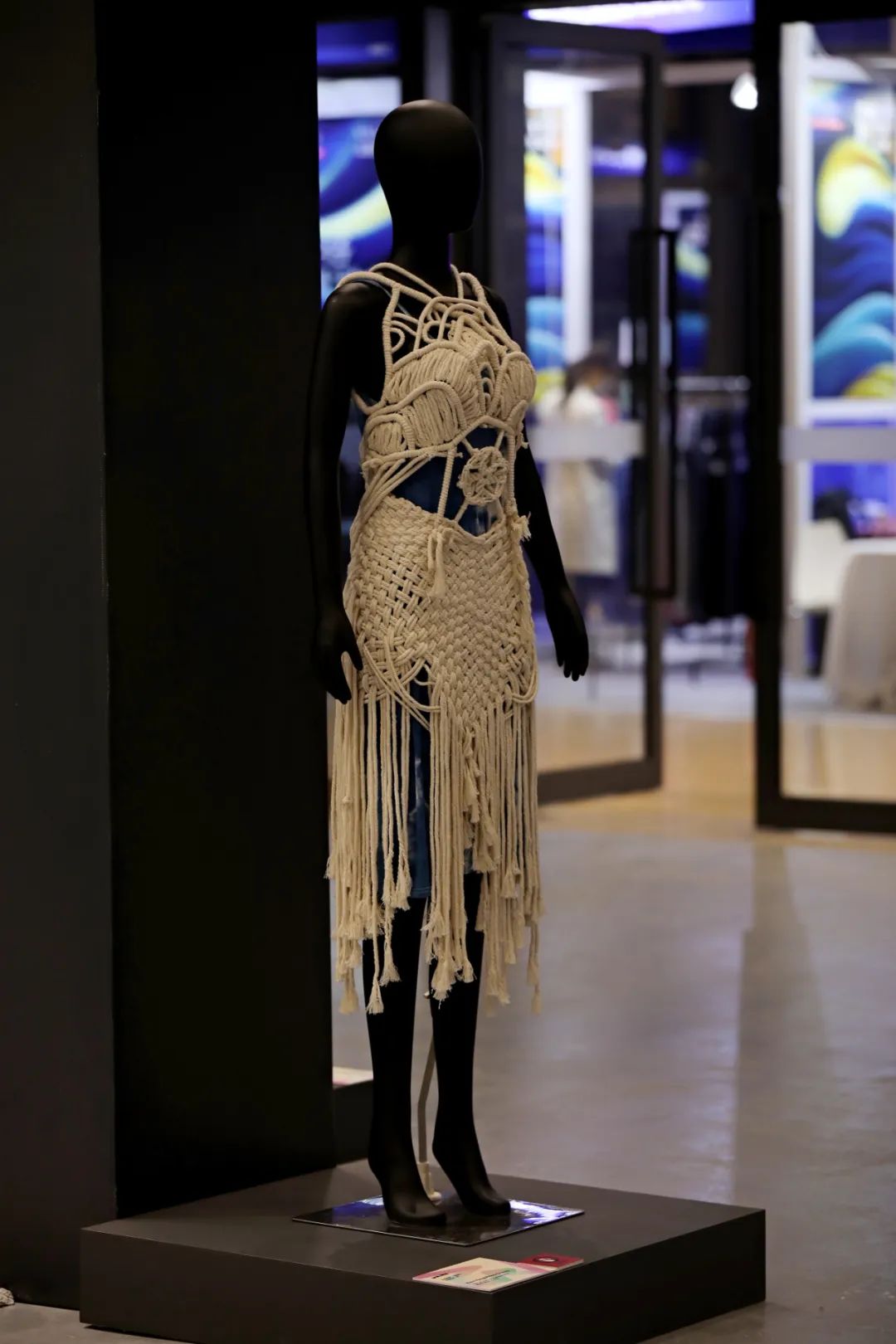
艺术家:郑格菲
作品名称:《人间烟火》
Title of w
ork: The Human World's Hustle and Bustle
作品材质:布、条形码
Mater
ial(s): Fabric, Barcodes
作品阐释:
条形码是数字时代商品信息的组成代码,衣装则可通过不同的设计语言塑造、润色和装饰着我们的生活。作品《人间烟火》以近几个月作者及家人、朋友所用到的商品条形码为材料,以自己最喜欢穿的一条长裙为形式载体构建而成。从组成长裙的条形码中,折射出作者生活中所买的所有快递(外卖、奶茶、学习用品等),及爸妈买的日用品、食品、化妆品、外婆的药、还有舅妈家小店买的货及小姨收发的顺丰快递单等。作品背后蕴含着当下人的生活习惯及消费观念的状态,呈现出新时代的“人间烟火”气息。
Barcodes are served as the foundational codes of information in our digital age, while clothing speaks a unique design language that shapes, enriches, and adorns our lives. The artwork "The Human World's Hustle and Bustle" is a creation born from the barcodes of products used by the artist, her family and friends over the past few months. It takes the form of a long dress, a personal favorite of the artist. Within the intricate tapestry of barcodes that comprise this dress, one can discern the traces of deliveries from various aspects of the artist's life, including takeout, bubble tea, study materials, as well as daily essentials, groceries, cosmetics purchased by her parents, her grandmother's medicines, merchandise from her aunt's small shop, and parcels sent and received by her aunt. This piece of work subtly encapsulates contemporary lifestyles and consumer values, presents the essence of our modern era's “nustle and bustle of human World.”
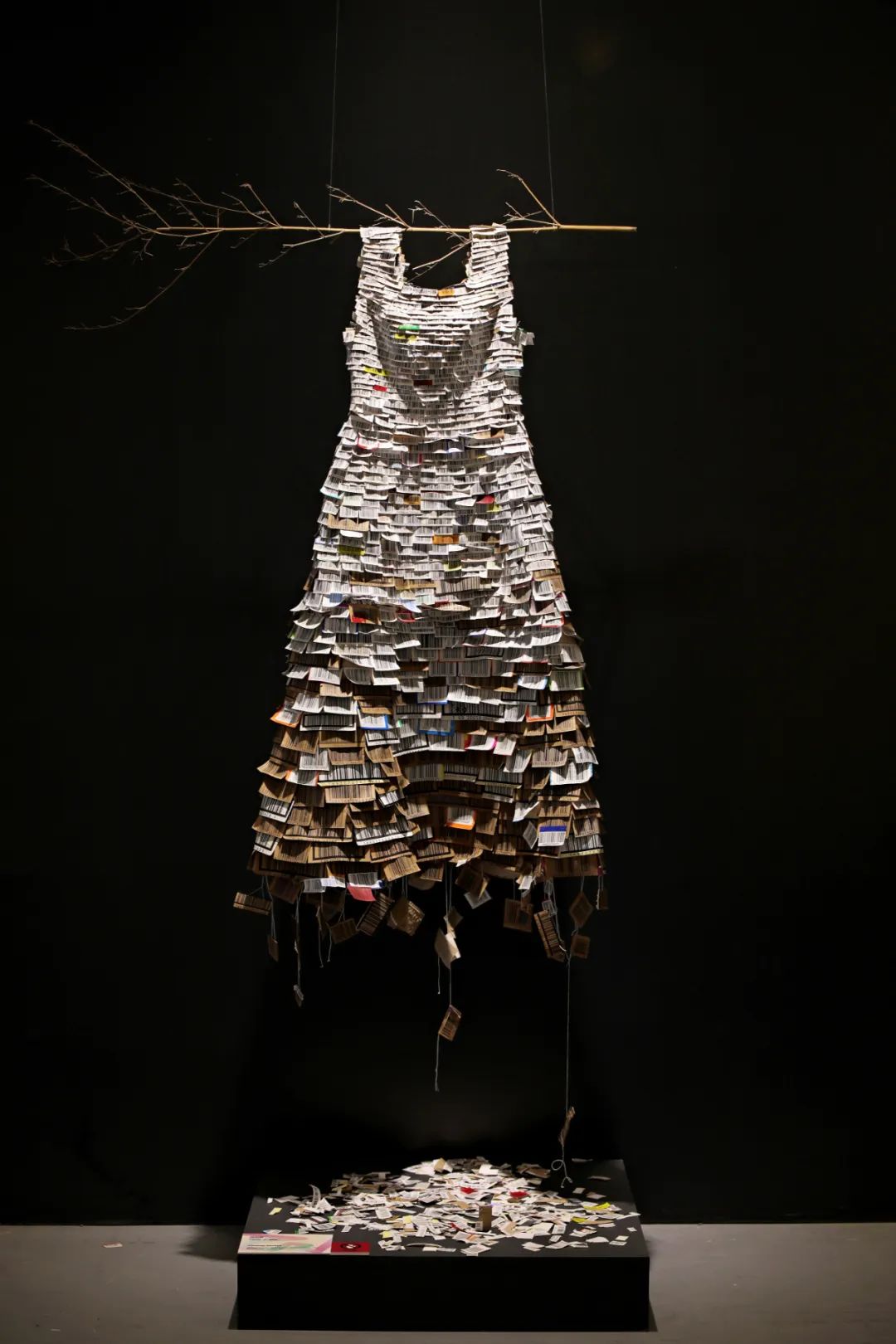
艺术家:龙雨虹
作品名称:《印迹》
作品材质:真丝绡、棉麻
Materia
l(s): Silk gauze, cotton,linen
作品阐释:
彩陶作为新石器时代的文化形式,它代表了石器时代的审美需求。彩陶的艺术中融合了艺术家的思想,融合了人们生活的痕迹。彩陶图案来源于编织的模拟,劳动的节奏感,图腾的标号化,自然物的模拟......以彩陶文化为载体,从历史的文脉中找到现代发展的方向,在文献资料的搜集中,我发现关于传统纹样遇见传统元素如:剪纸,窗花,油纸伞,松竹梅等在服装设计上的应用很多见,但是关于彩陶纹样在服装上的应用很贫乏,所以研究彩陶文化在服装设计中的应用中有更深层次的意义。如何将彩陶元素运用在服装上是我在设计中要探讨解决的问题。
As a cultural form of the Neolithic age, painted pottery represents the aesthetic needs of the Stone Age. The art of painted pottery integrates the thoughts of artists and the traces of people‘s lives. Painted pottery patterns come from the simulation of weaving, the sense of rhythm of labor, the labeling of totems, the simulation of natural objects... With painted pottery culture as the carrier, we can find the direction of modern development from the historical context.
In the collection of literature materials, I found that there are many applications of traditional patterns and traditional elements in costume design, such as paper-cut, window cut, oil-paper umbrella, pine, bamboo and plum, etc., but the application of painted pottery patterns in clothing is very poor, so the study on the application of painted pottery culture in costume design has deeper significance. How to apply painted pottery elements to clothing is a problem that I want to explore and solve in my design.
